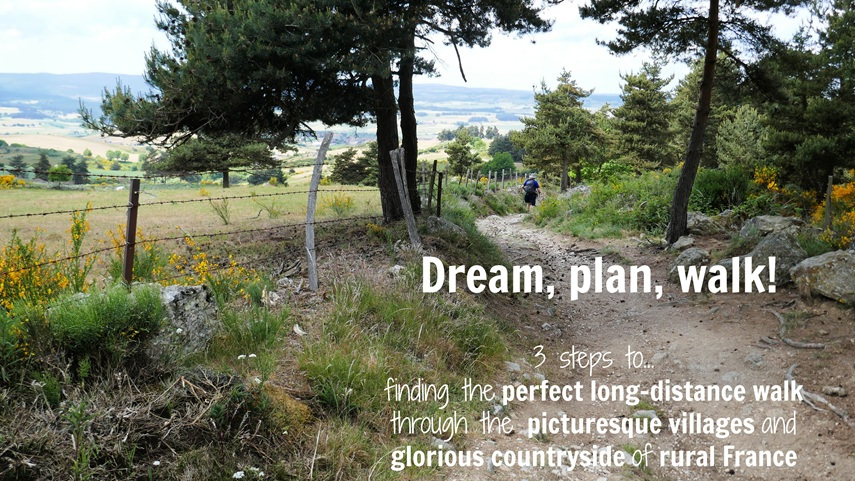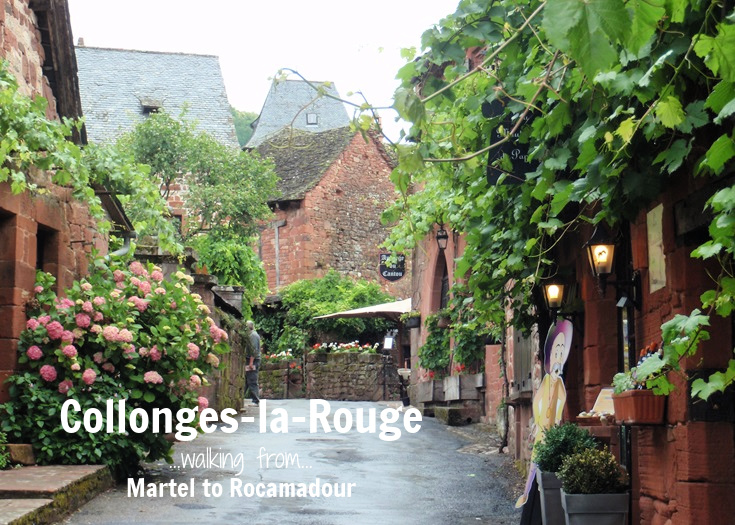
(Published January 2013, last updated March 2025)
Founded by monks in 785 CE around a priory gifted by King Charlemagne to the Abbey in nearby Charroux, the breathtakingly beautiful village of Collonges-la-Rouge has grown and prospered throughout the centuries.
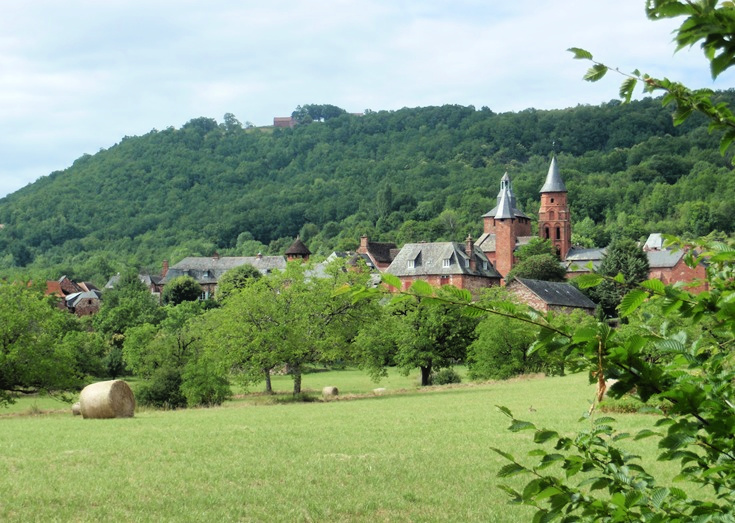
By the Middle Ages, a tiny village had grown around the priory. Houses were built from a cheap and abundant supply of red sandstone, but in order to give impressions of wealth, most homeowners hid this common building material under a layer of stucco. Regulations commonly stated that the stucco must be painted in a light colour to brighten up the dark, narrow alleys and by the fifteenth century most houses in Collonges-la-Rouge would have looked like the house below.
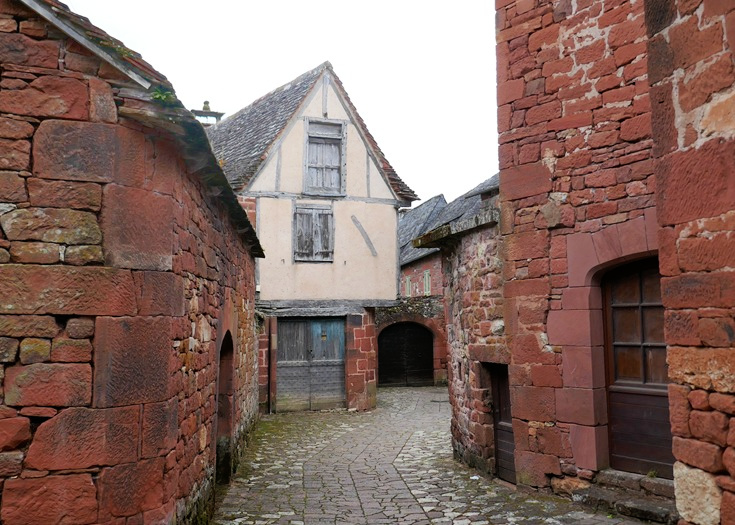
Fast forward five hundred years to 1981. The mayor, Charles Ceyrac, is dismayed as large numbers of the younger generation leave Collonges-la-Rouge and other nearby villages searching for work. As the villages become abandoned and neglected, he dreams of ways to breathe life into the tiny towns with a steady supply of visitors supporting a thriving hospitality industry and artisan foods and crafts.
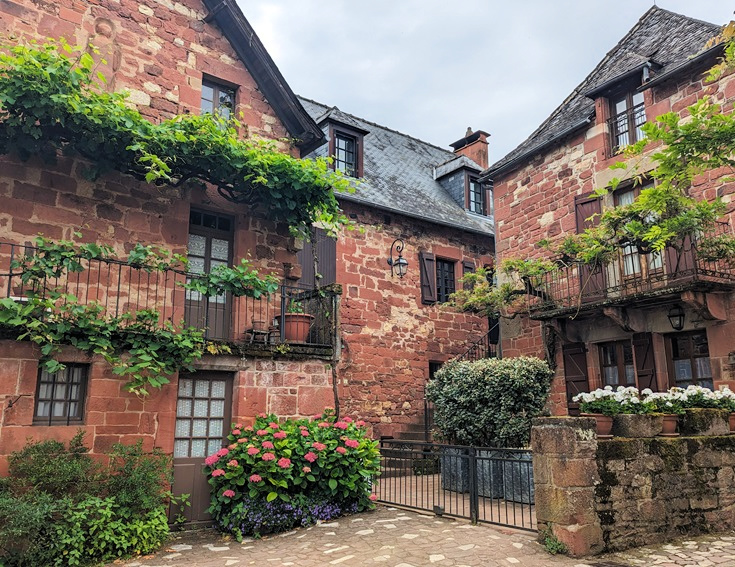
A charming courtyard facing Chapelle des Pénitents
Collonges-la-Rouge is the original ‘most beautiful village in France’
Centuries of grime and stucco were chipped away to reveal the beautiful red stone for which Collonges-la-Rouge is famous. A year later, the mayors of 66 other villages were onboard, agreeing to meet a set of criteria to qualify as one of the ‘most beautiful villages in France’ which include:
- A rural setting;
- A population of less than 2,000; and
- At least two historical monuments or sites which the town would commit to protecting and preserving.
Today, 180 villages have met the criteria necessary to join the ranks of ‘most beautiful villages in France’. In addition to Collonges-la-Rouge, you’ll find eight others on this walk including Martel, Turenne, Curemonte, Beaulieu-sur-Dordogne, Autoire, Loubressac, Carennac and Rocamadour.
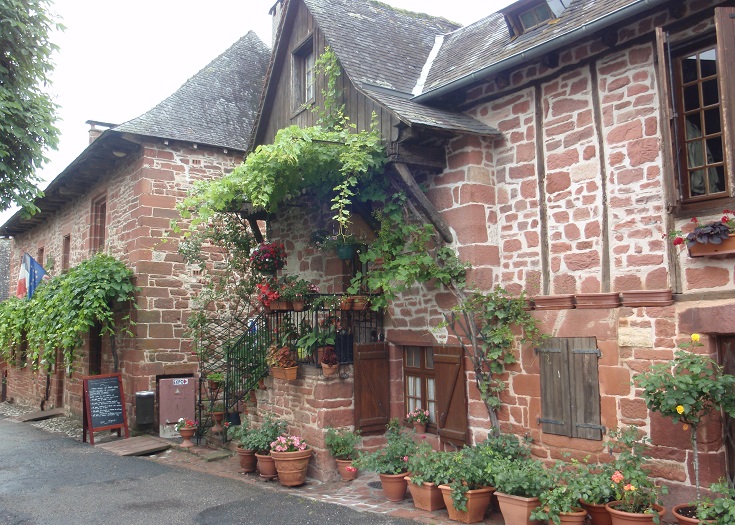
Pretty as a picture – the main street of Collonges-la-Rouge
Collonges-la-Rouge today
Although its fortunes have sometimes fluctuated—a thriving wine industry was decimated in the nineteenth century by an outbreak of phylloxera—Collonges-la-Rouge now enjoys a flourishing economy, supporting local artisans and welcoming visitors.
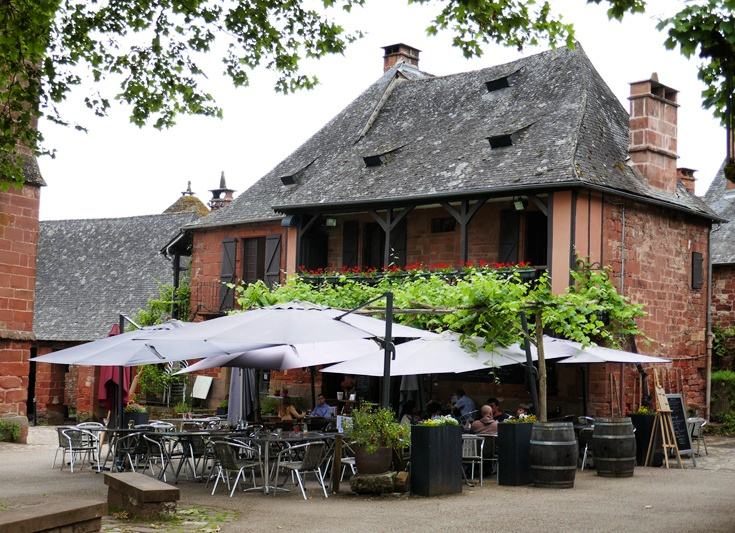
If you are following my suggested itinerary along the walk from Martel to Rocamadour, you’ll arrive in Collonges-la-Rouge late in the morning on the second day, after a short walk from the ‘most beautiful village’ of Turenne.
You could grab a quick lunch and rush on to the next ‘most beautiful village’ of Curemonte, but I recommend spending the night here in the village.
With all afternoon free, there is plenty of time to explore Collonges-la-Rouge, still my favourite ‘most beautiful village’.
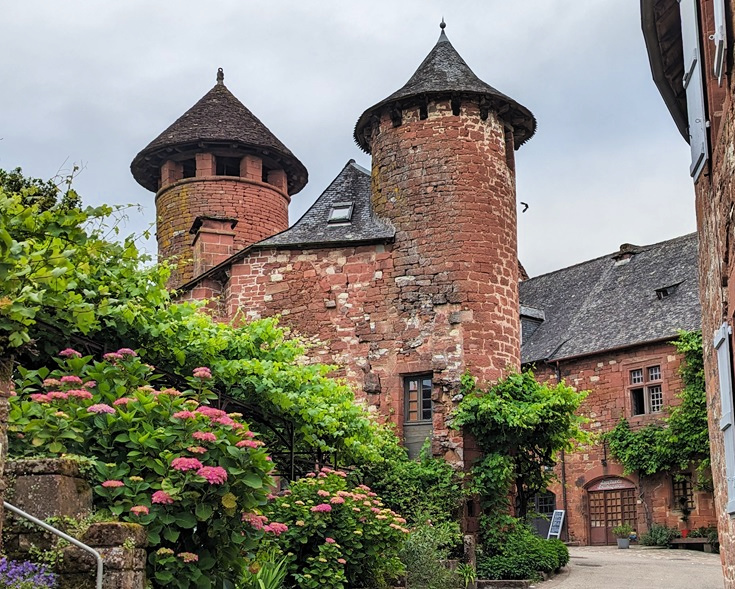
The fairytale turrets of Hôtel de Friac
In 1912, a rail line opened, linking Turenne, Collonges-la-Rouge, Meyssac and Beaulieu-sur-Dordogne (what a blessing that would be for weary walkers today!) Unfortunately, the service suffered a series of accidents and derailments which resulted in several fatalities, and the last train passed through the village in 1932.
As you arrive in the village, call into the Tourist Office which has relocated to the old café servicing the station on the main road facing the street which leads down through the village. Ask for a map of the town which will guide you past several buildings of historical significance.
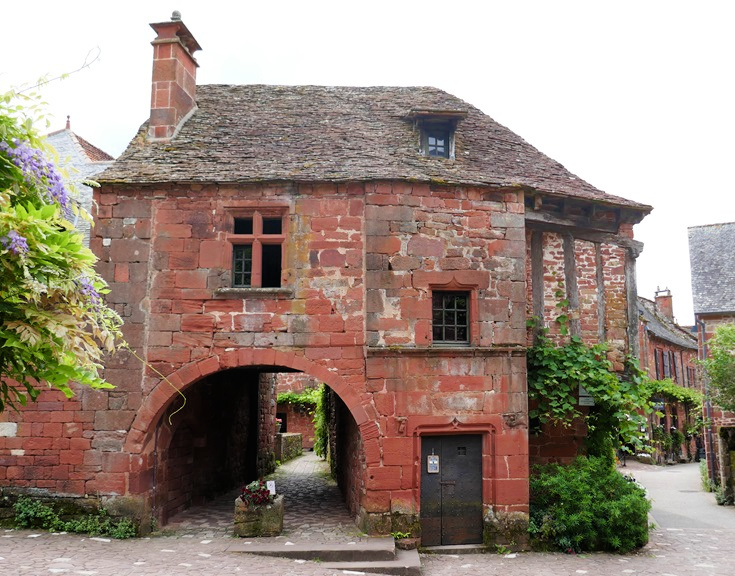
Maison de la Sirène
As you wander down the main street, you’ll see the sixteenth century Maison de la Sirène whose front entrance is adorned with a sculpture of a mermaid. Inside is a museum displaying household items and a fascinating collection of photos from the past. (Check the website for tariffs and opening hours.)
If you can, I recommend waiting until after you have explored the village and are familiar with the sights before visiting the museum. To see the homes and monuments as they are now and to then recognise them as the background to daily life in earlier times, is a memorable and touching experience.
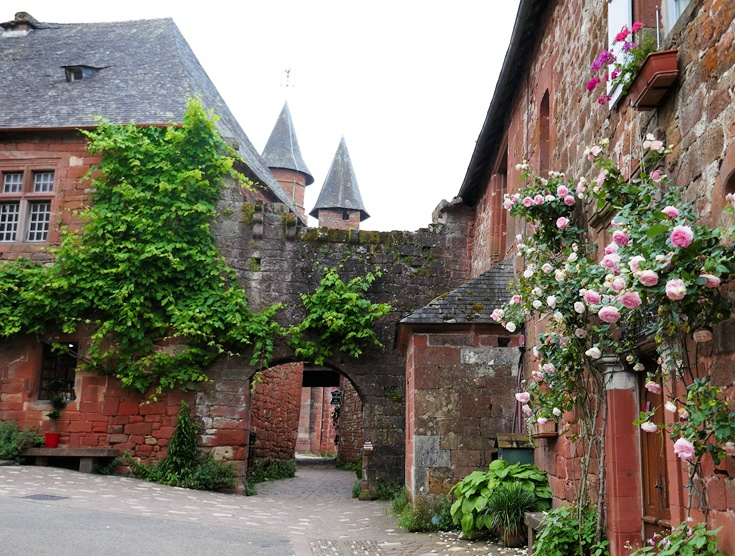
Porte Plante leads to the market hall, communal ovens and Église Saint-Pierre
Continue down the street until you reach the round turrets of the fifteenth-century Hôtel de Friac. Turn left and pass through Porte Plate to reach the covered market hall which was built in the early seventeenth century.
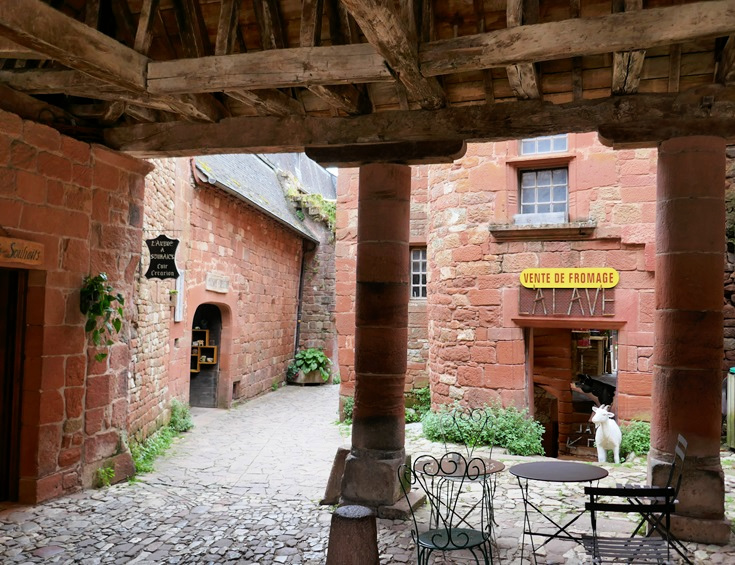
The covered market halle
On the far side, is the communal oven where villagers came to bake bread. Although the oven continued to be used until 1969, it is now only lit during the annual bread festival held on the first Sunday of August.
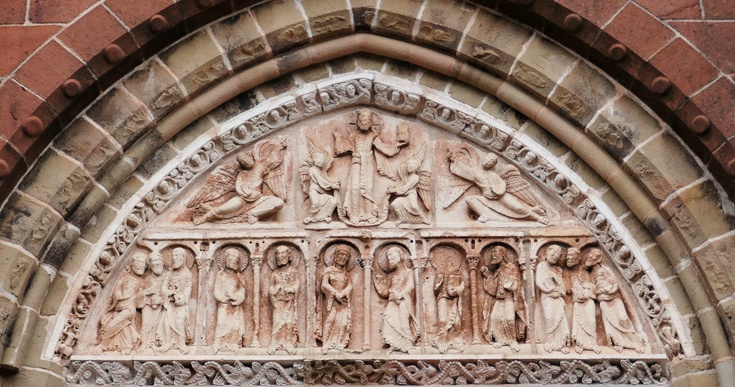
Tympanum above the entrance to Église Saint-Pierre
Facing the covered hall is Église Saint-Pierre. Much of the story of Collonges-la-Rouge can be told through the history of this beautiful Romanesque church which was built in the second half of the eleventh century.
The octagonal bell tower was added in the twelfth century and by 1140, the tympanum, carved from white limestone, greeted worshippers above the entrance.
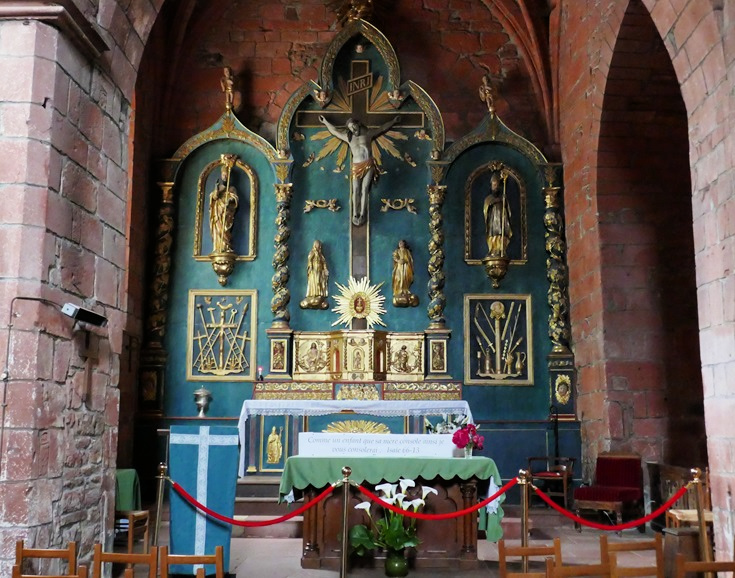
The altar in Église Saint-Pierre
At the end of the fourteenth century, during the Hundred Years War, the church was fortified and a second nave and bell tower were added. Two centuries later, during the Wars of Religion, the church was further fortified with the addition of the square watchman’s tower equipped with archery slits. Nonetheless, the area (under the rule of the Viscounts of Turenne) fell to the Protestants.
The villagers, who remained faithful to the Catholic church, dismantled the tympanum and hid it within the gable wall for protection. It was unearthed in 1923 and soon restored to its original position.
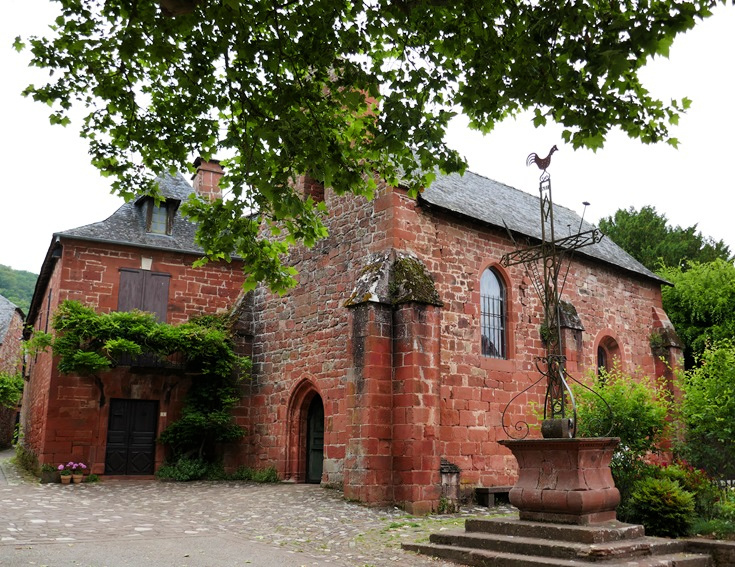
Chapelle des Pénitents Noirs
Behind Église Saint-Pierre, you’ll find the Chapelle des Pénitents Noirs, where local villagers—who were not allowed into the abbey—worshipped. When the brotherhood disbanded, the chapel fell into disrepair. In 1927, the Friends of Collonges Association began work to restore the roof, and contemporary stained-glass windows were added in 2016, flooding the interior with colour.
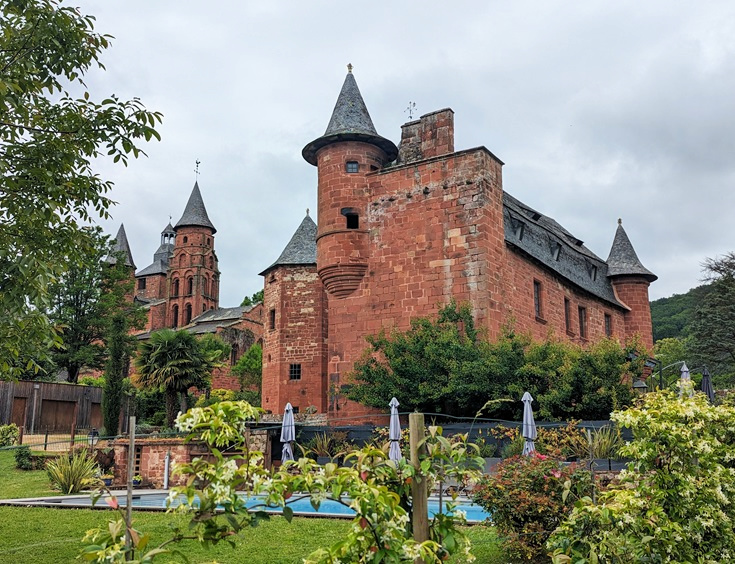
Château de Vassinhac with the towers of Église Saint-Pierre in the background
Continue your walk, following the lane behind the church around to the left. You’ll soon reach Château de Vassinhac, built in the fifteenth century for the Vassinhac family who ruled Collonges on behalf of the Viscounts of Turenne.
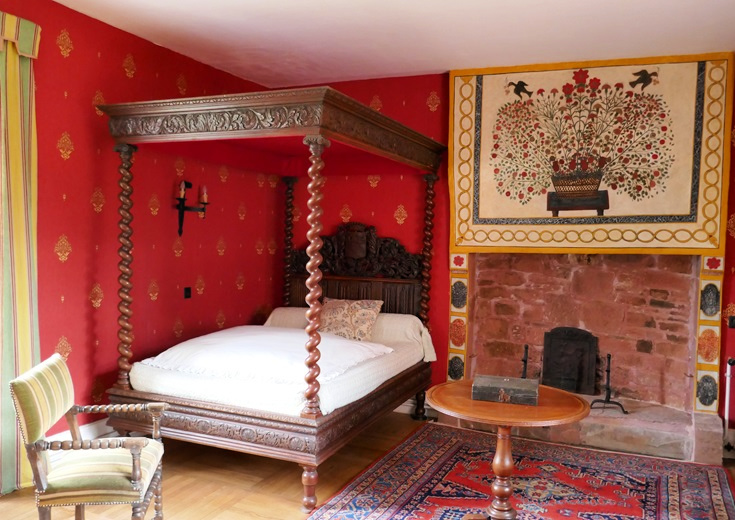
A bedroom inside Château de Vassinhac
The château has been lovingly restored by the current owners and the work involved is easily appreciated in a photographic exhibition on display in the cellar. The interior is richly decorated in period furnishings, and is open to the public every day. (Check the website for tariffs and opening hours.)
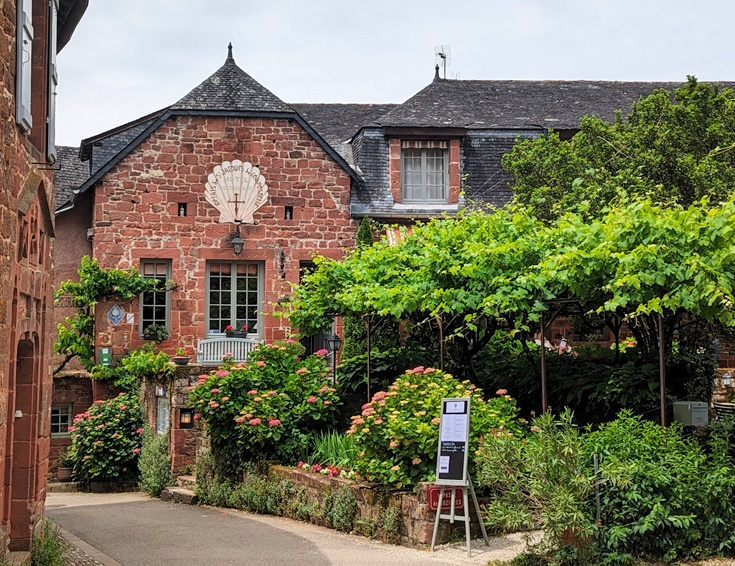
Relais de Saint-Jacques
FAST FACTS
Which long-distance walk in France visits Collonges-la-Rouge?
Martel to Rocamadour
Look inside the MARTEL TO ROCAMADOUR (PDF) guidebook
Where is Collonges-la-Rouge, France? Find it on Google maps
Collonges-la-Rouge is 26.8 kilometres (16.8 miles) from the starting point of Martel.
The village is one of nine of France’s most beautiful villages which you will visit on this walk. The others are Martel, Turenne, Curemonte, Beaulieu-sur-Dordogne, Autoire, Loubressac, Carennac and Rocamadour.
If you are following my suggested itinerary for this nine-day walk, you’ll arrive in Collonges-la-Rouge late in the morning on the second day of the walk, after a short 8.8 kilometre (5.5 mile) walk from Turenne.
If you prefer to set your own agenda, I share the steps I take to plan my itinerary on any long-distance walk (using the Chemin de Stevenson as a case study).
Transport options to and from Collonges-la-Rouge
Corrèze bus ligne 223 connects Collonges-la-Rouge with Turenne (with stops at the village and the train station), Meyssac, Ligneyrac and Brive la Gaillarde. (From the link, click on Trouver votre ligne de car, and search for Brive la Gaillarde.)
Tourist Office in Collonges-la-Rouge
You’ll find the Tourist Office on the main road facing the street which leads down through the village. Opening hours are listed on the Tourist Office website.
A map of the village is available at the Tourist Office or can be downloaded from the Dordogne Valley website.
Accommodation in Collonges-la-Rouge
Hotel
Le Relais de Saint-Jacques (highly recommended)
Chambres d’Hôtes
Château de Vassinhac (3 rooms, 6 people)
La Fermette (2 rooms, 4 people)
Domaine de Peyrelimouse (2 rooms, 4 people)
Le Jardin de la Raze (3 rooms, 6 people)
Campground
Campground de Collonges-la-Rouge
How to book accommodation in French
Where to eat in Collonges-la-Rouge
There are more cafés in Collonges-la-Rouge that you could possibly hope to eat at in less than a week. They all look wonderful! Take your pick!
Practical tips for long-distance walking—preparation, packing and avoiding blisters
Purchase the Martel to Rocamadour (PDF) guidebook
